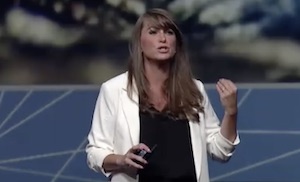 Many Americans are struggling with burnout, which if left unaddressed, can affect not only an individual’s wellbeing, but the success of firms, according to Jennifer Moss, a burnout expert and author of The Burnout Epidemic.
Many Americans are struggling with burnout, which if left unaddressed, can affect not only an individual’s wellbeing, but the success of firms, according to Jennifer Moss, a burnout expert and author of The Burnout Epidemic.
Speaking at the NAPA 401(k) Summit Sept. 13, Moss discussed the current realities of burnout and shared prevention strategies and tactics to manage burnout during times of stress.
In rebutting a New York Times article that called burnout a “whiny Millennial problem,” Moss contended that burnout affects everyone. In fact, the root causes of burnout include overwork, lack of control, insufficient rewards, loneliness, lack of fairness and mismatched skills—all of which have been exacerbated by the work-from-home environment of the last 20 months.
Many are feeling emotionally distanced from their work because they’re on Zoom all day, or they’re on emails or are overworking, and are not feeling as connected to the mission of their jobs, Moss explained. “And what’s so important about understanding this is that we often try to solve burnout with self-care—more yoga, better breathing, let’s download an app that helps us to better meditate, or we listen to rain for 15 seconds. That’s not going to solve these massive macro issues when it comes to burnout. And yet that’s how we’re trying to solve it—and it’s not working,” Moss said.
Citing research she did with other experts in burnout, Moss noted that 89% of respondents indicated that their work life was getting worse since the start of the pandemic; 85% said their wellbeing had declined; and only 2% rated their wellbeing as excellent.
Increased Workload
A big part of this, Moss noted, has to do with increased workload and people working longer hours since working from home. According to the research, people have been working 30% more to hit the same goals. They also found that the number of meetings had increased by 24% and that most respondents had added nearly an hour to the work day. And that overworking leads to exhaustion, which causes “brain fog,” she noted.
Moss also addressed the contention that people who are passionate and love their jobs will avoid burnout, pointing to the saying, “If I love what I do, I'll never work a day in my life.” “And that is completely ridiculous because I know, as a person who loves what I do, it’s very easy for me to forget to do things, like take care of myself and sleep, and not get obsessed with what I’m working on,” Moss emphasized. And while noting that having purpose and meaning are excellent motivators, she warns that if it gets to where it becomes obsessive, it becomes dangerous.
Moss suggests that one of the things that should be done is to first identify whether someone is burning out. In yourself, the signs include exhaustion, engagement and cynicism, while in others it includes fatigue, withdrawing, increase irritability, increased sick and late days, and disengagement.
“Are we mentally and emotionally distanced from our work? Do we feel like we don’t really know why we’re doing what we’re doing? Are we so tired that it’s sort of disconnecting us from what we’re doing every day?” Moss observed in explaining the signs of burnout.
Another issue, according to Moss, is that many people are continuing to react like we are in an emergency, such as when the country first shut down in March 2020. “Yes, we’re in a crisis, but we’re not in an emergency. And so, what we need to do is understand that this might be endemic and might be part of our lives,” she noted.
Preventing Burnout
So how do we create sustainable non-emergency ways of dealing with burnout? One way, according to Moss, is to look at workload as one major root cause.
She explains, for example, that many people still have their same pre-COVID ambitions and expectations, but when they are not achieved, that leads to anger or stress with themselves or members of their team. “We have to realize that this is not business as usual right now, even though for many, it’s high growth mode,” Moss notes.
One recommendation is to have weekly 15-minute conversations and check-ins among coworkers and leaders that has nothing to do with work. “We have found that if we have these conversations, it dramatically impacts and reduces the chance of burnout, but also increases trust,” she explained.
Moss also recommends digitally detoxing. “So many of us are just completely absorbed and exhausted by Zoom right now, or whatever video conferencing we're using. We need to be making sure that we’re taking breaks for people that are still working remote.” Moss suggests taking a “fake commute,” such as a 15-minute drive to a coffee shop or a walk around the block.
She also suggests tracking daily routines and making sure people are taking time for self-care. “Are we eating lunch at our desk every day? Are we answering emails at 11 o’clock at night and six o’clock in the morning? How often are we doing that? We need to be tracking and documenting that,” she recommends.
In closing, Moss urged attendees to be thinking about what has been learned from the pandemic and to look at it as a catalyst for intentional future behavior. “Yes, we are dealing with burnout. It’s a macro issue, but there are prevention strategies that can solve it. And we can do things as individual that take care of ourselves first, because if we are leaders, we need to model the behavior. Employees can’t be what they can’t see. And if we don’t act accordingly, that will never change in our organizations,” Moss concluded.

